
36 minute read
WHITEBOG SALERS
Journalism and photographs by Jelignite Ltd
Advertisement
Peter Willcox has lived and farmed at Erpingham House Farm, Norfolk, his entire life.
Born and brought up on the family farm, he took on the role of sharing the management of the business, alongside his mother, from an early age. He was given the trust and authority of a cheque book and at the age of 17 and made his first major purchase, his first tractor. The family have farmed at Erpingham house since 1904, where Peter now lives with his wife Kate and their two children aged three and one. Peter was very keen to point out that at the age of 87, his mother Mary still plays an important active role in the business, to this day, and one of those vital roles is looking after the accounts and online VAT returns.
The farm currently runs a herd of 40 beef suckler cows, of which ¾ are now Salers cross. Alongside the cattle enterprise, the farm produces hay and haylage, for horses and yards in the area. They have also diversified into several different enterprises; these include their own livery yard and holiday cottages. Two key seasonal markets they have capitalised on are asparagus in the early part of the year and for winter they also produce Christmas trees. Kate is a florist and with that they have recently diversified into growing around an acre or so of peonies. This level of diversity keeps them busy all year round. The farm consists of two main blocks of land, with Erpingham House having around 100 acres, to the North of the City of Norwich and the second block of land, of similar size (100 acres), located on the marshes directly to the South of Norwich. Around 15 miles separates the two and until the recent opening of the Northern Distributor Road, in 2018, travelling between the two necessitated going directly through the city. The focus for the cattle enterprise is down on the marshes. Norfolk has over 25,000 acres of these very fertile grass floodplains, that are used primarily to support livestock. Although Norfolk is best known for its arable land, livestock numbers are considerable, and you only have to look at the number of entries for the annual Royal Norfolk Show to see how important livestock is to the area. Cattle and sheep, grazed on the marshes and supplemented with the by-products of the arable industry, make for an efficient and cost-effective system. Straw is also not a scarce resource in these parts, although the increase in biomass power generation has had some impact on supply and prices. Historically the cattle enterprise began with Peter’s grandfather who set up the herd of Red Polls, for milking, just after the second World War. The herd grew to number 50 head of cows, until they decided to get out of milk and the cows were eventually sold to a welsh dairy farmer, who wanted their milk for cheese making. Peter says the decision to sell the milking cows occurred at the most inopportune time, right between the end of the first “Golden Handshake” era and before the introduction quotas. The herd was then restarted, this time with a focus on beef. Sticking initially to the Red Polls, but soon beginning an era of experimenting with the introduction of continental bulls, looking for easier calving. Initially using Simmental bulls, the herd grew to 150 cows across some 300 acres of marsh grazing. Although the marshland was spread around in pockets and became a 70-mile round trip just to check on the herd. As the herd grew the Red Poll cows were slowly replaced with Simmentals and then began a move toward using Blonde d'Aquitaine bulls. This proved successful, to a point. Peter says that with a careful choice of bull, the Blonde was a good cross, however with a run of several Blonde bulls they experienced increasing calving difficulties, culminating in three caesarean deliveries one spring. With that, the Blonde’s time had passed. Peter could not see any benefit in having to absorb the increasing vet bills and difficulties around calving time.
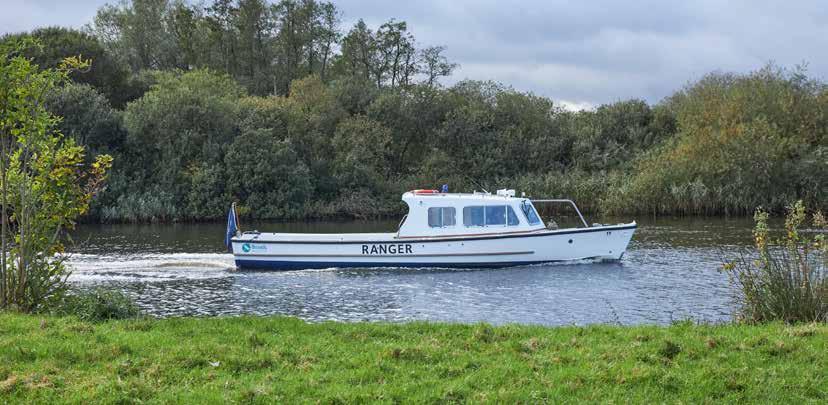
Looking to return to easier calving, Peter was recommended to try Salers. Peter took that recommendation and the nucleus of the Salers started with six heifers, bought from Ian Livingstone. The herd was downsized to the current level and likewise the area grazed was reduced to 100 acres on this the single continuous block of marsh land, thus reducing the overall travelling time and difficulties of managing a larger herd spread over a wide area. Another benefit to this was they now produced more hay than the needs of the herd, which could now be turned into a business opportunity, selling on to the horse market. I met Peter down on the marsh. The land lies on the inside of an oxbow, formed by the river Yare as it meanders its way east towards Great Yarmouth. Characterised by the thick peat underbelly and criss-crossed with drainage dykes, with a plentiful supply of nutrients and water. The banks of the Yare and the dykes are lined with reeds and in places the land lies beneath the water level of the Yare itself. Although hard to imagine, while the cold rain was falling on us as we walked across the marsh, Norfolk has a very low annual rainfall and Peter tells me that, within reason, he is able to control the height of the water table using a simple dam of planks across the dykes. The marsh is an incredibly open, flat area and despite the drier climate it is prone to the cold in the spring compounded by the bitter easterly winds. The cattle start off grazing one half and are then allowed to graze across the whole area once the hay has been taken from the remaining half. Although he has various people who come to check on the herd, he tries to get there himself at least three times a week. The cattle stay here throughout the year, grazing the marsh from mid-April until November. They then spend the winter in an open strawyard to protect them from the worst of the weather. Peter finds this promotes good lung health and cases of pneumonia are exceptionally rare. Muck from the deep beds is given to another local farmer, in exchange for the following season’s straw. Apart from the recently purchased yearling bull, yet to be introduced, it is a closed herd and they are within a four-year TB testing area. This keeps disease away from the herd. In fact, the biggest health hazard for the cattle comes from snakebites. Adders are commonplace on the marsh, especially during the warmer summer months. Although the snakebites themselves are not lethal to the cattle, Peter says that they develop a fever and in order to cool-off can end up drowning in the dykes or river. Calving starts as early as possible in spring and since introducing the Salers he has not had any need to use the calving jack. “We’ve probably saved at least £2000 per year in vet’s bills alone” says Peter. That’s key to how the system works. Lower maintenance and almost self-sufficient in its simplicity, rather than pushing towards diminishing returns. The cattle from the previous year are sold as yearlings the following spring. Peter sells exclusively through the local Norwich Cattle Market. It’s a vibrant market which is well supported in the region and Peter says the prices there are always good. “I really like the way Salers breeders are very mindful of the commercial side of the business” says Peter. They produce animals that are reliable and consistent, which is just what he needs. “The store buyers at the market always comment on how good my cattle are” says Peter, “They like to see a margin in it; something they have room to bring on themselves”. Historically this has always brought Peter a good price and a ready market for his animals. “Buyers also like to take from the market and put them straight back on the marsh”, he said, “They can see through the woolly coats and know these animals won’t be knocked back after being turned out”. The calves are all started on 16% protein creep, in the spring. If needed, he will creep feed in the Autumn, too, although grass has been plentiful this year. Milk is particularly important and plays its part in deciding which heifers to keep as replacements; “good milkers bring on the best calves and those are the ones we keep”, he said. This ‘selfselection’ reflects well on the system and as the Salers impart greater and greater influence, the improvements are self-evident, with lower costs and strong margins. The heifers are then bulled-up, aiming to calve them at just over two years old. The standing stock bull is a Black Salers out of a Rigel cow, Rigel Perdita, which Peter bought as a heifer from the Newark multibreed Sale. He is sired by a bull from A & M Austin, Morwenstow. He is 7 or 8 years old now and Peter has bought a yearling bull as his replacement for next year. The youngster is this time a Red Salers from Harperley Salers; Peter’s focused on bringing more red through the herd, because the local buyers better associate the Salers with the red colour and so he feels they are more distinguishable as Salers when brought into the market. Peter prides himself on producing good cattle, for a good market with good prices. Combined with a strong advocacy for supporting the local market he believes that “The cattle should keep you, not you keeping them”, which highlights the fact that life is very busy and your time is finite. Choosing the Salers and producing them in the way he does allows him to not only produce profitable, well sought-after, store cattle, but also to have time for the many diversified enterprises and a young family.
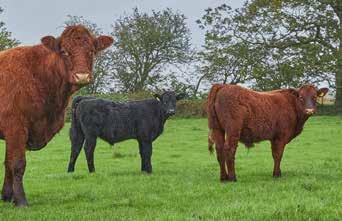
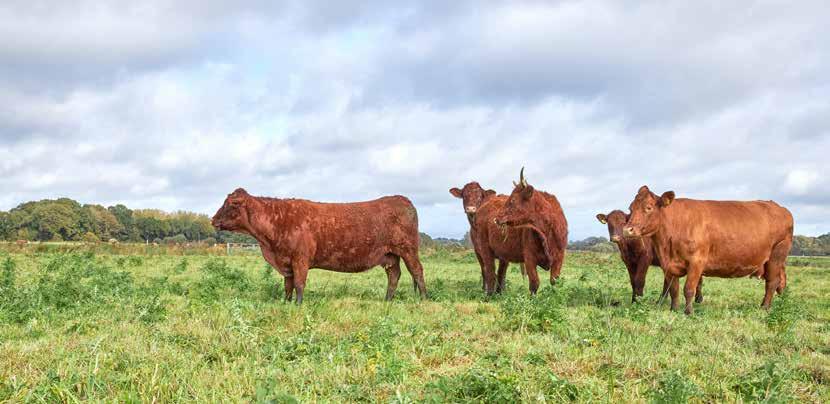
THE PERFECT BREED FOR THE PART-TIME FARMER! By Seamus Connell
Northern Ireland is a small country with 247,000 beef cows divided across 25,000 suckler farmers. The average suckler herd size is 18 cows. Due to the profits in Suckler cows, most of these farmers work a second job during the day and farm during their evenings and weekends. For this reason, myself and many others have chosen the Salers cow as their chosen breed in their herd. Other farmers are now starting to realise what the Salers breed can do to add the benefits of ease of calving, low maintenance, fertile, milky cow with a good temperament. I am very lucky to live with my wife, Christine, and my parents on a small family farm in the south of County Down, here in Northern Ireland. I work full-time for a local engineering firm and farm ‘part-time’ when I can. The recent Covid-19 lockdowns have made me appreciate the farm we have even more. Although only 40 acres in size, it is a welcome treat to stretch your legs in the evenings and walk the paddocks through the Salers cows with their Salers and Charolais calves at foot. The latter bred into the herd for exhibiting to potential customers. The cow type we like are medium framed, thick and square. They should have good milk, good on their feet with an easy temperament. Farming part time, you want to be able to move and work the cattle without difficulty. We are members of a Beef Development Group. We have learnt to run a paddock grazing system to get the most out of the grass. The cows are moved daily into fresh grass with the previous paddock topped and rested for 21 days until the next rotation. We find that regularly moving the cows into fresh grass, gets them used to you. They will follow you anywhere. The above project all started more than fifteen years ago. We would have travelled to the weanling marts in autumn, trying to buy the best Charolais or Limousin ‘lumps’ we could reasonably afford with the aim to house over the winter months. They would then be grazed the following year to be brought onto beef. At the time, weanlings were getting dearer to buy and we decided to investigate breeding our own. We first saw the Salers breed at the Balmoral show in the old Kings Hall, Belfast. They were very impressive on the cattle lawns and for us, they stood out among the other popular breeds. A few months later, we read a write up in our local farming newspaper to advertise the annual Salers breeding sale. The article included how this breed can calf unassisted to any breed including heavy muscled Charolais. This in-turn also reduced vet fees and helped to add some profit. The slogan on the advert was ‘sleep easy – breed Salers’. We thought we would give it a go. August that year, I was working away from home, and I had asked my father to go to the then Annual Salers sale in Omagh and see if he could buy two Salers cows as a trial. My Father, went to the sale and came home with our first two springing Salers cows from the Woodlawn herd, Killyleagh. Within 6 weeks, both cows had calved the two nicest dark red Salers heifers - unassisted. We were hooked. Over the next few years, we reduced the stock of weanlings and increased the cow numbers, buying from other Salers herds across Ireland. Upon joining the Salers society as a member, we were invited to join the local area 4 meetings. The meetings are a good way to talk more about the breed, discuss upcoming promotional events and making friends with other breeders. Before long, I had got myself a job helping to show cattle at the Balmoral show, later that year. This taught me more about the characteristics of the breed and it was not long before I began to exhibit my first Salers heifer under the prefix of Ballykeel Salers at a local show. We were placed last in the class that day, but it did not matter, it was the taking part that meant more.

Throughout the next few years, we have learnt more about the bloodlines, improved our genetics with the use of artificial insemination and aimed to buy nice females as our foundation stock from other top Salers breeders. I have got more involved in the Society by taking up the position of secretary in our area 4 group. I was later voted in as council member for Northern Ireland, giving me some involvement in the Salers council meetings with representatives from other areas of the society. We upped our game showing our cattle, the competition improved with banter and craic amongst the other breeders. The highlight of our shows was winning champion out of seven out of eight shows. Winning a champion at Balmoral show is still on my bucket list. The points collected from the shows helped us to achieve UK animal of the year with our Salers cow, Indiana. This year, we are now running 20 head of Salers with 20 followers. Half of the Salers cows going to our stock bull, Jocker and the remainder, mostly his daughters being inseminated with Salers semen imported from France. Recently, we have been using straws from the Salers bulls, ‘Imperial’ and ‘Icare’. We try to keep two or three heifers each year to build the herd with the rest of the females being sold from the yard through local advertising. The best of the Salers bull calves are sold for breeding at 12 to 16 months. We AI one or two of our average Salers cows to a Charolais bull to show visitors what the breed can do commercially. This year we have used Caveland Fenian and Doncamillo. Since we have had our first Salers cow on the farm, we have only assisted one calf at birth. This calf was not presented correctly. We find the breed just calve themselves. Over the last 18 months, the demand for the Salers breed is starting to take off, in particular the females. Breeders across Northern Ireland have no trouble selling Salers heifers, with demand out stripping supply. Many of the larger Salers breeders in Northern Ireland also run Charolais or ‘Culard’ Charolais bull onto their Salers cows. Their calves are being born unassisted and the trade that they are making for their ‘golden eggs’ at the suckler sales are a welcome advertisement for the rest of the Salers breeders in the country. Our plans for the future, will be to stick with a pure Salers herd. We would like to improve the quality of our bloodlines. Due to daughters kept, we will replace our ‘Trin’ stock bull Jocker with a bull of equal or greater quality. We hope to get back out to the local shows soon and continue to help to promote the breed to others. We find the Salers breed to be the breed for us, the part time farmer and we hope many more realise that the Salers has a place in todays low labour cost system.


SALERS - THEY DO EXACTLY WHAT A COW SHOULD DO! By Lynsey Clark and MacGregor Photography
In a quest to simplify their cattle system, increase profits and for ease of management, the McIntyres introduced Salers to their Aberdeenshire-based suckler herd back in 2009, and the breed has delivered on all of those points and more.
“We were previously buying in replacement heifers, which was causing us to spend too much time away from home at breeding sales, plus they were costing too much money and we were not getting the consistency we were looking for with the calves. We wanted to be able to breed our own replacement females that we could cross with the Charolais, to produce calves that we could sell at any stage of life,” says Jamie McIntyre, who farms in partnership with his dad, Ian, at Milton of Cullerlie, Echt. Also involved are Jamie’s mum, Audrey, his wife Kirsty, and their three young sons, Hamish, Lachlan and Robbie.
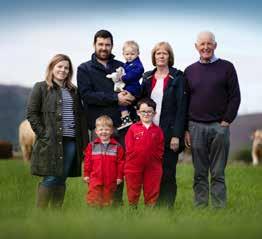
Alongside the farm, the father and son also run a ground and garden maintenance business, which takes them away from home three to four days a week – so having an easily managed system at home is a must. “We knew the Salers crossed well with the Charolais and that they were good mothers, so we bought some heifer stirks from Castle Douglas in 2009, from herds including Cuil and Mains of Penninghame, and continued to do that each year until 2013. We aimed to buy growthy, square females with good tops that were good on their feet and legs,” explains Jamie. As the herd has developed, the heifers and second calvers now go to the Salers bull, to breed replacement females, while third calvers go to the Charolais. However, Jamie says they will occasionally bring some of the older, most consistent breeders back to the Salers bull. “By breeding our own replacement females, we can afford to be particularly selective when choosing the traits we want to breed for and can make longterm improvements to the herd. It’s also better for herd health – we’re essentially a closed herd now, only buying in breeding bulls.” With this system, the McIntyres have increased their herd size from 45 cows to 85 and have put their 150 ewes away, to solely concentrate on making the most of the cattle. Jamie says: “With the simpler system and the cows now being easier managed, it has allowed us to increase the numbers which we keep at home – we have 160 acres at the farm and rent ground away from home for silage and yearling male stirks. Because we’re working away a lot, it’s easier for us to have most of the cattle at home, in the one place, and I don’t think we could have carried the numbers we have now with any other breed.”

The majority of the herd, and most of the Charolais calves, calve in the spring, from March 10th onwards. Bulls go out on 1st June for 12 weeks, however, Jamie says the majority (73.5% this year) calve in the first three weeks and the rest in the following three weeks. “All except the heifers calve outside. One of the traits that attracted us to the Salers was their big pelvis and we really have very few calving issues. This spring, we had to help one cow with twins that were coming backwards and we had one heifer that needed a pull.” After calving, the spring cows and calves are rotationally grazed in paddocks through the summer, maximising grass utilisation for the cows to produce lots of milk for their growing calves, with the calves creep fed from mid-August until they are weaned mid-November.

“With the combination of rotationally grazing paddocks and the Salers natural foraging ability, we can carry around 20% more cows and calves on the same grazing platform than we did previously,” says Jamie. Last year, Charolais cross bullock and heifer calves averaged 352kg off their mothers. With an average 40kg birth weight, that’s an average daily liveweight gain of 1.3kg. Jamie adds: “The calves aren’t creep fed a particularly fancy feed, the emphasis is on getting milky cows to produce plenty of milk.” Cross calves are wintered on silage, home-grown barley and bought-in dark grains. They’re then sold the following spring, through the ring at Thainstone Mart, at 12-13 months, weighing 450-480kg. Jamie says: “Charolais crosses sell very well at Thainstone, there’s always plenty demand for them. We graze the spring-born Salers bullocks and any heifers we’re not keeping for breeding and fatten them to sell in the backend, aiming for a maximum 380kg on the hook for bullocks and a bit lighter for heifers. The bull calves not being kept for breeding or selling are all castrated for ease of management, we don’t grow enough barley to fatten beef bulls.”

The McIntyres have seen a noticeable improvement in the consistency of their calves, which was one of the main aims when moving to Salers. This makes it easier to determine which cows and calves are performing best, but it also enables them to market the calves better in batches, despite not having huge numbers. “Before, when we had different breeds, the calves were all sorts of sizes and colours, but now they’re like peas in a pod. The Salers calve easily, with a good vigorous calf, which is easily sellable through the live ring,” says Jamie. The back-end calvers are mainly calving to the Salers bulls (currently Cuil King and a home-bred bull by the French AI sire, Geronimo). They are AI’d for heifers to calve from midSeptember and cows from 1st October, with the Charolais bull put in to sweep anything that’s left. Those calves suck all summer, which helps prevent mastitis and they are weaned 5-6 weeks before the cows are due to calve again. The majority of pure females are kept for replacements, but they sell some commercial bulling heifers at 15-18 months-old and some in-calf heifers. When selecting which heifers to keep for breeding, Jamie says they first go by the history of the dam, then good feet and legs are a must, as are a good top and a wide frame. And he says they like femininity too. “We like a cow that looks like a cow, if that makes sense! They should also be able to walk the earth without needing their feet trimmed and have plenty milk. We don’t have an age cut-off point for cows; if they are producing and rearing a good calf every year then we’ll keep them. Breeding our own replacements allows us to be very selective in which females we keep.” “The Salers are great mothers – they do exactly what a cow should do; have a calf unassisted, look after it well and get back in calf again, and they do that year after year.” Jamie also finds them easy to work with, which he says is essential. “We wouldn’t have the breed if we were worried about their temperament – we genuinely find them very quiet and easily managed. It’s not something that we’d tolerate, especially with Dad and I working away and our three wee boys here. We need to be able to trust the cattle.” As well as simplifying the cattle system, the family hoped to make it as efficient and low cost as possible, which they feel they’ve achieved with the Salers and Charolais cross. But, they’re not complacent; they plan to continue to improve the breeding herd and keep pushing for higher output. “The cows are easily kept through the winter – we can put an extra couple of cows to a round bale and they can winter on fairly low quality silage. For what we’re aiming to achieve and for the system that we have, I can’t think of a better cross than the Salers/Charolais,” adds Jamie.
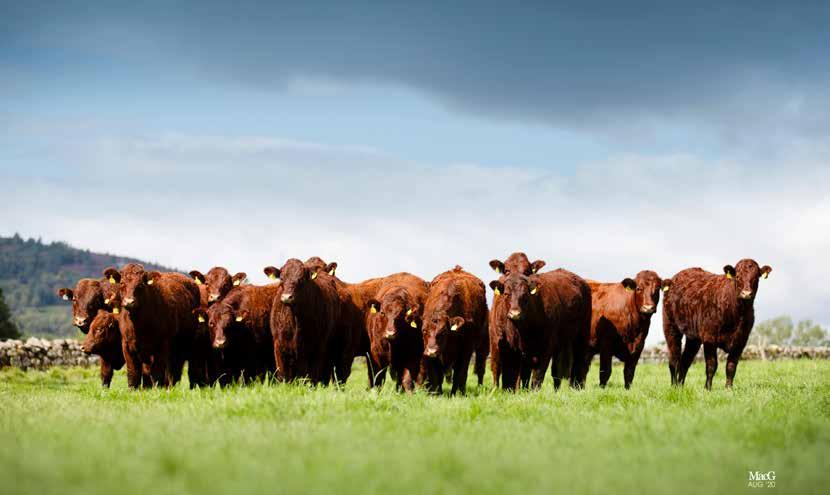

FINISHING BULLS AT A YOUNG
AGE MAKES MORE SENSE By Countrygirl Media
A simple system which fits around the farm’s other enterprises makes Salers the ideal choice for Pwllheli-based Aled Jones, his brother, Endaf and mother, Catherine.
Running alongside a 150-ewe Lleyn flock and an extensive caravan park and holiday cottage business, the 110-cow Wenol herd has to be easily managed and efficient. “We are a busy farm, with the tourism diversifications taking up a significant amount of time during the summer months, meaning we want our farming system to be allow us the time that business demands.” “The suckler herd fits well in our system, but we need a cow which can calve herself, mother her calf well and get back in calf easily,” he explains. Having first introduced Salers to the farm with a batch of heifers bought from France, the family have since converted the entire herd to pedigree Salers, with the herd run on a commercial basis and every cow treated exactly the same. “The herd now numbers 110 cows, with calving taking place from early April onwards and 70% of the herd calving in the first three weeks.” “This exceptional fertility is one of the main reasons we’ve moved across to the Salers breed and continues to be a key driver in our commitment to the breed. On top of that the breed is particularly easy calving, with just one needing assistance at calving this year.” Cows calve outside, having been housed for as short a period as possible through the worst of the winter months to allow grass a recovery time. “Being on the Llyn peninsula our grass does tend to keep growing well through the winter and we take in 300 ewes for wintering, but it wouldn’t be possible to keep cattle out all year round,” he explains. Cows and calves are housed in November, with creep introduced to the calves from late August onwards to prepare them for weaning which takes place in January and ensure all calves grow on well ahead of housing. “Cows are out full time by the middle of March, with 40 acres left ungrazed over winter to give plenty of grass for cows at calving.” “While housed cows and in-calf heifers receive a simple diet of grass silage and minerals, with the aim being to have them in good condition for calving, but not too fit.” To maintain the herd’s high level of performance Aled operates strict culling policy whereby any cow requiring assistance at calving or any other issues are culled, as are those calving outside the preferred pattern. “Anything due to calve outside of a 12-week window is sold as an in-calf animal, maximising the value in them. However, due to the highly fertile nature of the herd that is generally only two or three a year.” “Heifers are calved into the herd at two-years old, with about 20 heifers retained each year, with the aim of keeping the age profile of the herd reasonably young. Surplus heifers are sold for breeding, with anything not suitable for retention or sale finished on-farm alongside the bull calves which are all kept entire and finished as bull beef at about 13 months old, with all of these sold deadweight to ABP.”

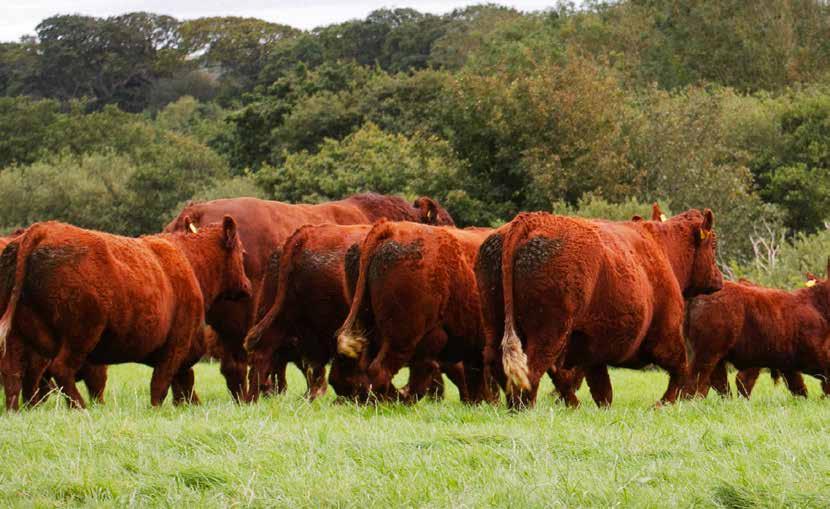
Aled says the aim with the bulls is to finish them as soon as possible, but also to ensure they have a good level of fat cover when they are sold. “We finish them on a blend which we have used for a number of years, it is higher in maize content than previous rations and this helps ensure they lay down fat at the right stage to meet the processor specification.” “Finishing the bulls at a young age makes more sense for us than taking them to the maximum weight as we have to buy in both feed and straw to finish them. With the higher maize content in the ration we are able to finish them easily at 12-14 months old, at an average carcass weight of 360kg and all grading either U3 or R3. Once they get past that age their feed intake tends to increase significantly and we don’t tend to see this back in the extra weight they gain.” A few top end bulls are also retained for sale as breeding bulls with these sold from home in recent years. “We sell heifers from home too, with a good demand for strong bulling heifers.” When it comes to serving, the herd is split in to three groups, bulling heifers, first calved cows and older cows. One bull runs with the bulling heifers, another with the first calved cows and two with the older cows, with all pedigree bulls run with the whole herd. “We don’t use any other breed and it works well. No doubt if we were selling the finished bulls on a liveweight basis they may not be suitable for some buyers, but on the hook they come to good money, so there is no need to change. On top of that we have the surplus pure heifers to sell which command a premium price,” he explains. With the herd having a high health status there is a ready market for these surplus heifers as recipients for embryo transfer programmes, adding another string to the herd’s bow. Stock bulls are sourced both privately and at Society sales, with the aim being to buy easily fleshed, correct bulls with the ability to breed medium sized cows with plenty of milk, but correct udders. “A bull’s dam line is an important part of our selection criteria and we currently have bulls from the UK and France in the herd, including Drumlegagh Granville, the overall champion at Castle Douglas in 2015 and Illamani, a French import from the Fourtet herd. “Another recent addition is Drumlegagh Hamish, another bull from John Elliott’s herd in Northern Ireland where a number of our early females came from.” Aled says the benefits of running a self-replacing herd mean he would be hard-pushed to switch now and the ability to cull hard due to the opportunity to replace problem cows with homebred heifers makes for a much more efficient and productive herd. “We never think twice about culling a cow that has had a problem of any sort, it simply doesn’t make sense to keep problems or carry passengers. We have enough work to do between the farm and the holiday park without making life any more difficult than it needs to be.” “Salers are the perfect cow for us and our farm and give us great versatility and flexibility in herd management,” he adds.
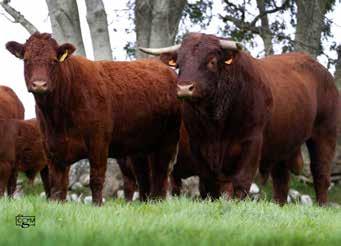


FARM PROFILE
Article Credit: Farmers Guardian, Author Jez Fredenburgh, Photographer P. Lack & Tim Scrivener
Share farming, care farming, and fine dining mix at Whitbourne Estate, Worcestershire, to create a more circular system. Jez Fredenburgh meets Joe Evans to find out more. Estate combines commercial and charity diversifications
The 607-hectare (1,500acre) Whitbourne Estate is in an enviable position. Just east of Worcester, it lies between the Shropshire and Malvern Hills Area of Outstanding Beauty, and the Brecon Beacons National Park. But sharing its natural assets with the public, alongside a growing list of commercial enterprises, is at the heart of its ethos.
Joe Evans, managing director and sixth generation to farm at Whitbourne, believes their estate can demonstrate to wider society that farms such as theirs are not ‘just about making money’.
He says: “We do lots of other things as well. That doesn’t need to be at the cost of farming, it can all work together in tandem. The industry is going through a lot of change and if we can be on the front foot of demonstrating our wider benefits, that can only be a good thing to secure the industry.” Experience Joe took over from his father, Bill, seven years ago to allow him to retire. Using his banking experience working in the Channel Islands, India, London and South East Asia, Joe has been expanding the estate’s commercial enterprises since then, while paying close attention to family values.
Joe says: “We decide our objectives together as a family. It’s normally about what we want to do in terms of environmental impact and what we want our farm to look like.”
A key aim is to create a more circular economy. The estate’s 182ha (450-acre) organic farm hardly buys any inputs other than straw for winter bedding, and a proportion of its finished beef and lamb is sold to the estate’s hospitality businesses. One of these businesses is
Green Cow Kitchens, a 30-seater fine-dining restaurant which Joe launched in a converted pig shed. A chef prepares seven-course tasting menus based on the seasons and uses as much from the estate as possible – wild boar, pheasants, partridges, apples, pears and herbs and foraged foods, such as damsons and elderflower. Joe would also like to try temporary stocking, such as ducks, for the restaurant.
“We can do eight to 10 lambs a month, but beef is more of a challenge because you end up with so much mince,” says Joe.
“But we want the restaurant to be a showcase for what British agriculture can do.”
Demand for the estate’s produce will soon increase, following the family’s investment in a new 200person event venue and business, Crumplebury, complete with 13 bedrooms. It will be powered entirely by a woodchip boiler using byproducts from Whitbourne’s forestry management activities.
The on-site care farm, Longlands, also makes use of the estate’s farm, with young students getting handson farm experience and providing extra help for activities such as moving stock. In addition, the estate has four let farms and 19 cottages.
But it is still a lot to juggle and has meant an expansion of the team.
Joe says: “When I took over, there were four of us at the Christmas dinner in the first year – last year there were 52, including staff and volunteers. It’s a big job to make sure that I have the brain space to help everyone do what they need to do.
“Before, we were just a very sleepy estate that could afford to be a bit more reactionary, but now we need to have a clear plan.
Joe Evans on the Whitbourne Estate, Herefordshire.
“The biggest challenge now is making sure Crumplebury is a success – we’ve borrowed a lot of money and will be opening the estate up more to the public. I need to make sure we don’t get too distracted by this beast and compromise our farm values.”


Share farming Part of that plan was taking nearly 121ha (300 acres) of farmland back in-hand to create a 182ha (450-acre) beef and sheep unit.
Tim and Lara Roberts run the organic unit with a hybrid agreement between contract farming and share farming. Tim is self-employed and farms on a contract basis, with all sales and bills going to the Evans family. But as the livestock builds up, a proportion of them will be owned by the Roberts. Tim and Lara bought half the farm’s existing flock of Lleyn sheep when they took over and have gradually built them up to today’s 400 ewes.
Tim says: “The aim is to sell breeding females as yearlings.
“We are crossing about 50 per cent to a Hampshire ram, which has been giving us higher growth rates, easier finishing and we’ve been getting some very good commercial carcases.
“They thrive off fresh air and a good view, which suits us since we’re very low input. We’re trying to be the best we can from what we grow.”
The couple also added their own herd of pedigree Salers cattle to the farm’s existing pedigree Beef Shorthorns. Now, numbers are up to 45 Beef Shorthorns and 30 Salers, and finished stock is sold to Meadow Quality and retailed under supermarket organic meat labels.







Tim Roberts runs the organic livestock unit for the estate.

Tim says: “They’re maternal beef breeds, so we also sell breeding females and the odd breeding bull to fatten. So, there’s quite a mixture of animals being sold, which helps with cashflow.”
To keep outside inputs to a minimum, the couple grows 4ha (10 acres) of spring oats, but is looking to expand the arable area. Tim grew 10-12ha (25-30 acres) of brassicas for the sheep this year in a rotation of temporary grass and red clover, but the brassicas suffered from flea beetle.


Care The Roberts also work in partnership with Longhands Care Farm, which Joe’s mother, Julia, established a decade ago and still leads. The charity is paid by local authorities and police to give vital support and education to vulnerable young people.
Through hands-on farm experience they can gain qualifications, including equine studies and tractor driving, and a new teacher will now teach GCSEs in maths, English and art. Up to 30 young people attend each week.
Under a large amount of supervision and safeguarding, the students

PICTURE: PAUL LACK
take part in various farming activities.
Joe says: “It’s really handy if I need help moving cattle of moving animals up the race.
“They arrive in their white trainers and hoodies on day one, nervous about being on-farm. My mother has a smart tactic of first introducing them to the guinea pig, and before you know it, they’re helping to handle cattle.
“They’re given gentle encouragement and they gain confidence, which is part of equipping them with life skills. These kids are in a perilous position in society, so it’s about trying to get them out of that cycle and give them a bit of belief. Being trusted to help Tim halter-train cattle is a pretty big step.
“It’s hugely gratifying to see




it for the estate. The estate’s flock of Lleyn sheep.

improvements in their chances and outlook.
“It’s part of what an estate can offer, which goes beyond the traditional and is about adding a little bit of societal good, sharing our natural environment and improving these kids’ lot.”
The estate also has 158ha (390 acres) of trees managed by a forestry team. Oaks are grown for high-quality timber, while general coppicing and thinning activities provide enough material for a small firewood business.
Nursery Joe says: “We also sell acorns to a nursery – trees themselves can be a yielding crop. You don’t have to cut them down to do something with them.”
The estate is also looking ahead with climate change in mind, to which species of fastgrowing non-native species might thrive there.
“We’re working with Tim to identify areas of grassland that aren’t particularly productive and thinking about turning them into forestry, as I think that’s going to be a really big part of where Government policy drives us.”
Managing the estate might be hard work, but it beats corporate life, says Joe.
“It’s a wonderful privilege to be able to do this because there are relatively few of us that are given the responsibility of managing land in this country. I have the privilege and responsibility to try and get it right.”
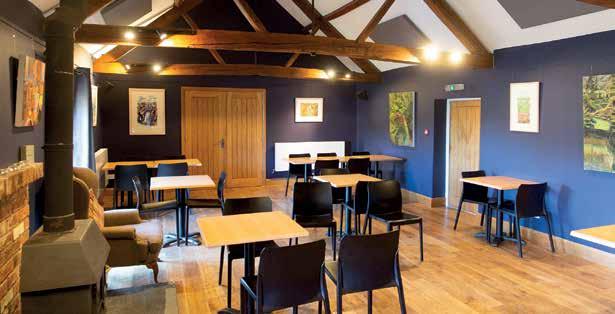
The care farm on the estate. The interior of the Crumplebury restaurant and event facility.

Crumplebury restaurant and event facility.
PICTURES: TIM SCRIVENER









